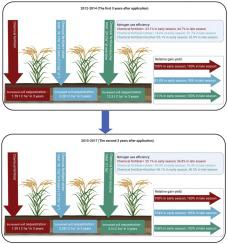Agriculture, Ecosystems & Environment ( IF 6.6 ) Pub Date : 2021-01-30 , DOI: 10.1016/j.agee.2020.107286 Ji Liu , Bingshen Jiang , Jianlin Shen , Xiao Zhu , Wuying Yi , Yong Li , Jinshui Wu

|
Increasing cropland soil carbon (C) sequestration and improving crop nitrogen use efficiency (NUE) are vital for sustainable agriculture and environmental protection. The incorporation of straw and application of straw-derived biochar to croplands may help to achieve these goals; however, the long-term effects on soil C sequestration and NUE in double-rice cropping systems are poorly understood. Here, a 6-y field experiment was conducted in a double-rice cropping system to investigate the variations in soil C sequestration and NUE with straw and straw-derived biochar amendments. The treatments were as follows: control with zero nitrogen (N0); conventional chemical fertilizer application (NPK); NPK plus 3 t rice straw dry matter (DM) incorporated per ha−1 season−1 (NPK + LS); NPK plus 6 t rice straw DM incorporated per ha−1 season−1 (NPK + HS); NPK plus 24 t straw-derived biochar DM incorporated per ha−1 (NPK + LC) applied once; and NPK plus 48 t straw-derived biochar DM incorporated per ha−1 (NPK + HC) applied once. Both the straw and biochar additions increased the soil C content in the topsoil, and the NPK + LC treatment sequestered 2.6-fold more soil C than the NPK + HS treatment over the 6-y period, when the input amounts of straw as well as the straw derived C were similar for both treatments. Besides input C directly into the fields, biochar application also increased soil original organic C accumulation in the NPK + LC treatment. Compared with NPK, 50 % and 100 % straw incorporation to the field increased the mean NUE by 22.3 % and 39.8 %, respectively, in the late rice season of 4–6 y, mainly due to increasing soil organic C. Rice grain yields decreased in the early rice season for the first 3 y of the straw treatments but increased in the first season when the biochar was applied, when compared with NPK. However, in the second 3 y after straw application, the grain yield of NPK + HS was significantly higher than that of NPK in late rice season. This investigation has indicated that biochar application had a higher potential in soil carbon sequestration than straw incorporation, and long-term (> 3 y) straw incorporation favored for the enhancement of NUE in paddy fields.
中文翻译:

稻草和秸秆生物炭施用对水稻种植系统中土壤碳累积和氮利用效率的对比影响
增加农田土壤碳(C)的固存和提高作物氮的利用效率(NUE)对于可持续农业和环境保护至关重要。将秸秆并入秸秆生物炭到农田中可能有助于实现这些目标;然而,人们对双季稻种植制度对土壤固碳和NUE的长期影响了解甚少。在这里,在双水稻种植系统中进行了6年田间试验,以研究秸秆和秸秆衍生的生物炭改良剂对土壤固碳和NUE的影响。处理如下:用零氮(N0)控制;用零氮(NO)控制。常规化肥施用(NPK); 每公顷-1季节-1掺入的氮磷钾加上3吨稻草干物质(DM)(NPK + LS);每公顷-1季节-1施用的NPK加6吨稻草DM (NPK + HS);每公顷-1(NPK + LC)加入NPK加24吨秸秆衍生的生物炭DM,施用一次;每公顷-1掺入NPK和48吨秸秆衍生的生物炭DM(NPK + HC)应用一次。秸秆和生物炭的添加都增加了表层土壤中的土壤碳含量,并且在秸秆输入量和输入量的6年内,NPK + LC处理比NPK + HS处理的土壤碳吸附量高出2.6倍。两种处理的秸秆衍生碳相似。除了将碳直接输入田间,生物炭的施用还增加了NPK + LC处理中土壤原始有机碳的积累。与NPK相比,稻田4-6 y时,稻田秸秆掺入量分别为50%和100%,平均NUE分别增加22.3%和39.8%,这主要是由于土壤有机碳增加。水稻籽粒产量下降与NPK相比,秸秆处理的前3年在稻作的早期稻米季节,但施用生物炭的第一个季节在稻米季节增加。然而,秸秆还田后的第3年,NPK + HS的籽粒产量明显高于水稻后期的NPK。这项研究表明,生物炭的施用比秸秆还田具有更高的土壤固碳潜力,长期(> 3 y)秸秆还田有利于提高稻田的NUE。


























 京公网安备 11010802027423号
京公网安备 11010802027423号